Product Images Lisdexamfetamine Dimesylate
View Photos of Packaging, Labels & Appearance
Product Label Images
The following 28 images provide visual information about the product associated with Lisdexamfetamine Dimesylate NDC 43602-552 by Ascent Pharmaceuticals, Inc, such as packaging, labeling, and the appearance of the drug itself. This resource could be helpful for medical professionals, pharmacists, and patients seeking to verify medication information and ensure they have the correct product.
30 - 30
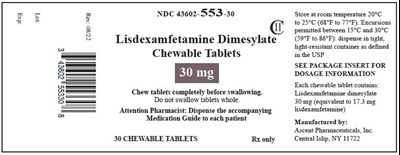
This text appears to be the label or packaging information for a medication called Lisdexamfetamine Dimesylate. The medication is available in chewable tablet form and comes in a package containing 30 tablets. The text instructs to store the medication at room temperature (between 20°C and 25°C or 68°F to 77°F) and warns against exposing it to temperatures outside of the range of 15°C to 30°C (59°F to 86°F). The tablets should be chewed completely before swallowing and should not be swallowed whole. The label also indicates that the medication should be dispensed in a light-resistant container. It advises the reader to refer to the package insert for dosage information and instructs pharmacists to dispense the medication to each patient. The location of the medication manufacturer is listed as Central Ilip, NY 11722.*
40 - 40
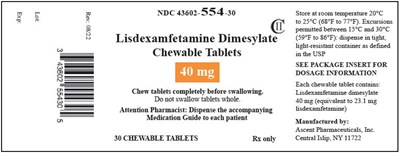
This is a description for a medication called Lisdexamfetamine Dimesylate Chewable Tablets. The tablets should be chewed completely before swallowing and should not be swallowed whole. The pharmacist should dispense the accompanying Medication Guide to each patient. The package contains 30 chewable tablets. The tablets should be stored at room temperature between 20°C and 25°C (68°F to 77°F), with excursions permitted between 15°C and 30°C (59°F to 86°F). The medication should be dispensed in a tight, light-resistant container as defined in the USP. The package insert should be referred to for dosage information. Each chewable tablet contains 40 mg of lisdexamfetamine dimesylate, which is equivalent to 23.1 mg of lisdexamfetamine. The medication is manufactured by Ascent Pharmaceuticals, Inc. located in Central Islip, NY 11722.*
60 - 60
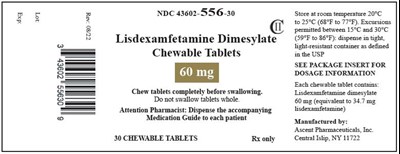
This text appears to be a description for a medication called Lisdexamfetamine Dimesylate chewable tablets. The medication should be stored at room temperature between 20°C and 25°C (68°F to 77°F), with excursions permitted between 15°C and 30°C (59°F to 86°F). The tablets should be dispensed in tight, light-resistant containers. The package insert should be consulted for dosage information. Each chewable tablet contains 60 mg of Lisdexamfetamine Dimesylate, and it is recommended to chew the tablets completely before swallowing. The medication is intended for use in patients, and the text may be associated with a pharmaceutical company located in Central Ilip, NY 11722.*
Figure5 - Figure5
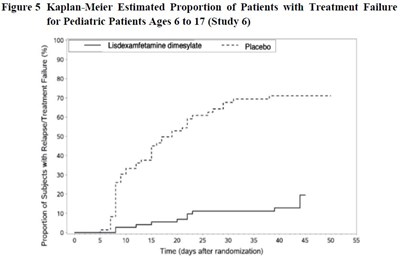
The text describes a figure titled "Kaplan-Meier Estimated Proportion of Patients with Treatment Failure" for a study conducted on pediatric patients aged 6 to 17 (Study 6). The figure shows the percentage of patients who experienced treatment failure for two groups: one receiving Lisdexamfetamine dimesylate and the other receiving a placebo. The x-axis represents the time (in days after randomization) and the y-axis represents the proportion of subjects with treatment failure.*
Figure6 - Figure6
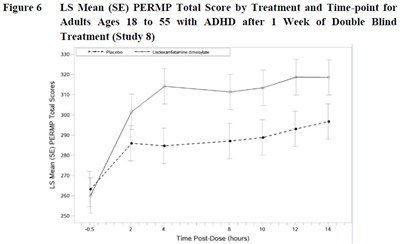
LS Mean (SE) PERMP Total Score is a measure used to evaluate the effectiveness of a treatment for adults aged 18 to 55 with ADHD. The data shown in Figure 6 indicates the scores obtained by participants after 1 week of double-blind treatment. The graph displays the scores at different time points post-dose (in hours) ranging from 0 to 10. Unfortunately, the rest of the text is not readable.*
Figure7 - Figure7
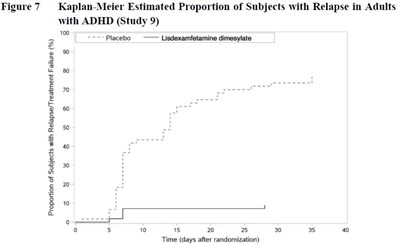
This is a Kaplan-Meier plot showing the estimated proportion of adults with ADHD experiencing relapse in a study (Study 9). The plot compares the relapse rates between the placebo and lisdexamfetamine dimesylate treatment groups. The x-axis represents time in days after randomization, while the y-axis represents the proportion of subjects experiencing relapse or treatment failure.*
image description - Figure8
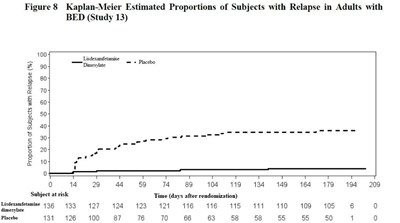
This is a description of a figure titled "Figure 8" which shows the Kaplan-Meier Estimated Proportions of Subjects with Relapse in Adults with BED (Study 13). The figure displays a graph with time (days after randomization) on the x-axis and the proportion of subjects with relapse on the y-axis. The graph includes two lines representing the treatment groups: Lisdexamfetamine dimesylate (10 subjects at risk) and Placebo (131 subjects at risk). The graph shows the proportions of subjects with relapse at various time points.*
mg1 - mg1

Selective Serotonin Reuptake Inhibitors (SSRIs) are medications used to treat conditions such as depression and anxiety. They work by increasing the levels of serotonin in the brain. SSRIs can also be effective in reducing the frequency and severity of migraines. Triptans are another type of medication commonly used to treat migraines and headaches. Other medications mentioned include lithium, tramadol, biispiiotia, serotonin norepinephrine inhibitors (SNRIs), tricyclic antidepressants, fentanyl, tryptophan, and St. John's Wort. Please note that the text is not complete or clear, so some information may be missing.*
mg2 - mg2
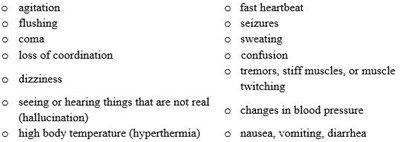
This text appears to be a list of symptoms and side effects related to a certain condition or substance. These include agitation, flushing, coma, loss of coordination, dizziness, hallucinations, high body temperature, fast heartbeat, seizures, sweating, confusion, tremors, stiff muscles or muscle twitching, changes in blood pressure, and gastrointestinal symptoms such as nausea, vomiting, and diarrhea.*
mg3 - mg3
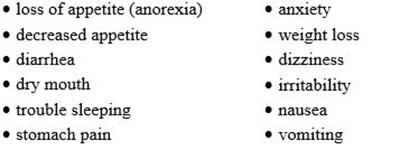
Loss of appetite, decreased appetite, diarrhea, dry mouth, trouble sleeping, stomach pain, anxiety, weight loss, dizziness, irritability, nausea, vomiting.*
mg4 - mg4

This text appears to be discussing possible symptoms or side effects related to a certain condition. It mentions dry mouth, trouble sleeping, decreased appetite, increased heart rate, constipation, feeling jittery, and anxiety. These symptoms may be associated with a specific medical condition or medication. However, without further context, it is difficult to provide a specific description.*
table1 - table1
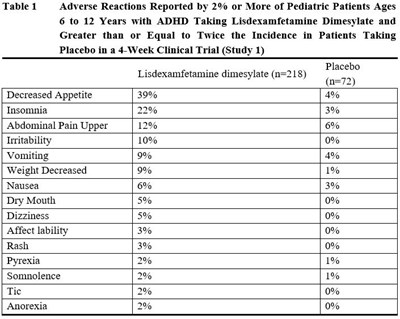
This text provides a table showing the adverse reactions reported by pediatric patients aged 6 to 12 years with ADHD who took Lisdexamfetamine Dimesylate in a 4-week clinical trial (Study 1). The table includes the percentage of patients who experienced each adverse reaction, compared to the percentage of patients who took a placebo. The adverse reactions listed include decreased appetite, insomnia, abdominal pain upper, irritability, vomiting, weight decreased, nausea, dry mouth, dizziness, affect lability, rash, pyrexia, somnolence, tic, and anorexia.*
table2 - table2
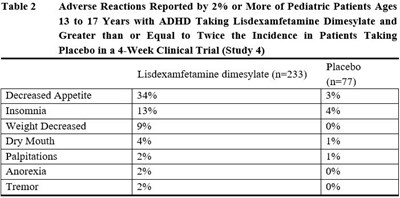
Table 2 shows the adverse reactions reported by pediatric patients aged 13 to 17 years with ADHD who were taking Lisdexamfetamine Dimesylate compared to those taking placebo in a 4-week clinical trial (Study 4). The table provides the percentages of patients experiencing each adverse reaction, with a focus on reactions that were reported by 2% or more of the patients taking Lisdexamfetamine Dimesylate and had an incidence that was at least twice as high as the patients taking placebo. The adverse reactions listed in the table include decreased appetite, insomnia, weight decreased, dry mouth, palpitations, anorexia, and tremor.*
table3 - table3
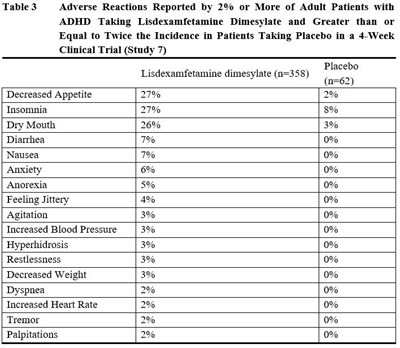
Table3: Adverse Reactions Reported in ADHD Patients Taking Lisdexamfetamine Dimesylate This table provides a summary of adverse reactions reported by adult ADHD patients who were taking lisdexamfetamine dimesylate in a 4-week clinical trial (Study 7). The data includes adverse reactions that were reported in at least 2% of patients and had a higher incidence compared to patients taking a placebo. The most commonly reported adverse reactions in patients taking lisdexamfetamine dimesylate were decreased appetite and insomnia, both reported by 27% of patients. Other reported adverse reactions included dry mouth, diarrhea, nausea, anxiety, anorexia, feeling jittery, agitation, increased blood pressure, hyperhidrosis (excessive sweating), restlessness, decreased weight, dyspnea (shortness of breath), increased heart rate, tremor, and palpitations. Please note that this information is based on the text provided, and the accuracy of the content cannot be guaranteed.*
table4 - table4
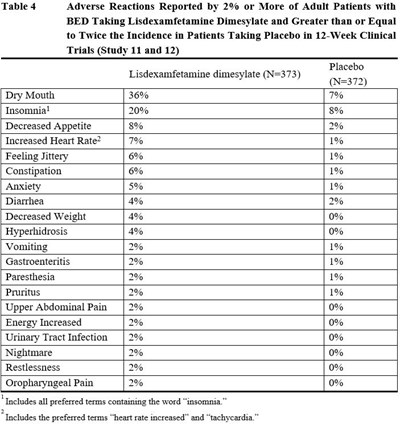
Table 4 shows the adverse reactions reported by adult patients with Binge Eating Disorder (BED) who took Lisdexamfetamine Dimesylate compared to a placebo in 12-week clinical trials (Study 11 and 12). The table indicates the percentage of patients experiencing each adverse reaction. Some of the adverse reactions reported by more than 2% of adult patients taking Lisdexamfetamine Dimesylate include dry mouth, insomnia, decreased appetite, increased heart rate, feeling jittery, constipation, anxiety, diarrhea, decreased weight, hyperhidrosis, vomiting, gastroenteritis, paresthesia, pruritus, and upper abdominal pain. Some less common adverse reactions included energy increased, urinary tract infection, nightmare, restlessness, and oropharyngeal pain. "Insomnia" was included in the preferred terms for adverse reactions, and "heart rate increased" and "tachycardia" were also noted.*
table5 - table5
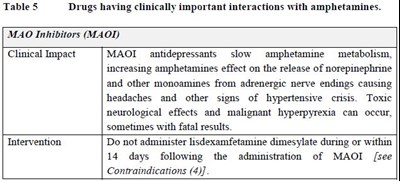
Table 5 provides information on drugs that have clinically important interactions with amphetamines. Specifically, it focuses on the impact of MAO inhibitors (MAOI) on amphetamines and their effects on the release of norepinephrine and other monoamines, which can lead to headaches and signs of hypertensive crisis. It warns against administering lisdexamfetamine dimesylate during or within 14 days of MAOI administration due to potential harmful effects, including neurological effects and malignant hyperpyrexia.*
table6.1 - table6.1
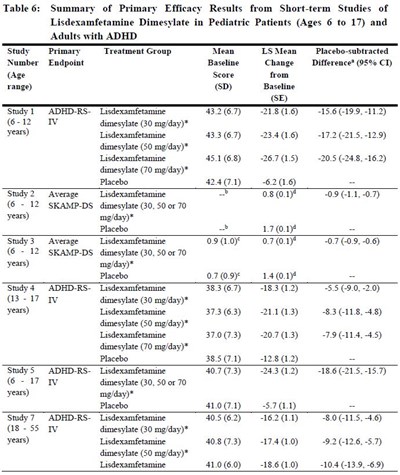
Table 6 provides a summary of the primary efficacy results from short-term studies of Lisdesamfetamine Dimesylate in pediatric patients (ages 6 to 17) and adults with ADHD. The table includes details such as the study number, primary treatment group, mean baseline score, baseline change, and placebo-subtracted difference. It shows the results for different doses of Lisdexamfetamine Dimesylate compared to placebo in terms of ADHD-RS and SKAMP-DS scores. The table presents the mean values and statistical measures for each endpoint.*
table5.1 - table6
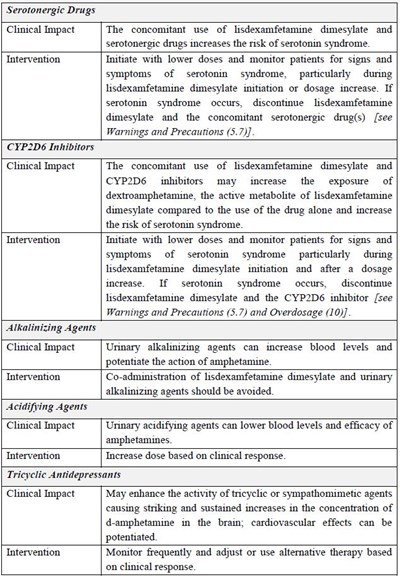
Serotonergic drugs, CYP2D6 inhibitors, alkalinizing agents, acidifying agents, and tricyclic antidepressants can all interact with lisdexamfetamine dimesylate, a medication used for the treatment of attention deficit hyperactivity disorder (ADHD). These interactions can increase the risk of serotonin syndrome, affect the exposure and efficacy of lisdexamfetamine dimesylate, and potentiate the cardiovascular effects of the medication. It is important to initiate treatment with lower doses, monitor patients for signs and symptoms of serotonin syndrome, and adjust or use alternative therapy based on clinical response. Co-administration of lisdexamfetamine dimesylate with urinary alkalinizing agents should be avoided, while dose adjustments may be necessary when using urinary acidifying agents. Regular monitoring is recommended when combining lisdexamfetamine dimesylate with tricyclic antidepressants.*
* The product label images have been analyzed using a combination of traditional computing and machine learning techniques. It should be noted that the descriptions provided may not be entirely accurate as they are experimental in nature. Use the information in this page at your own discretion and risk.









